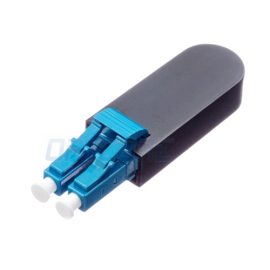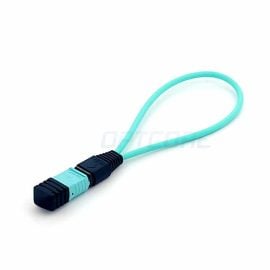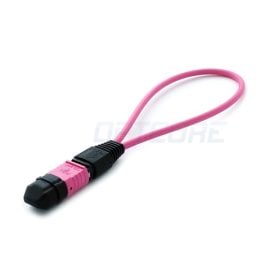-
×
 Singlemode SC Fiber Loopback Module
1 × US$ 3.90
Singlemode SC Fiber Loopback Module
1 × US$ 3.90
Blog, Network Cabling
Loopback Cable: What It Is and How to Use It
Network operators often carry a small item with them. This tool, called a loopback cable, is vital for troubleshooting network testing, diagnosing connectivity issues, and maintaining communication systems.
As a one-stop store for fiber optic solutions, we specifically write this article for you. It provides you with a better understanding of key aspects of loopback cables, including their definition, type, function, uses, pros and cons, and usage steps. Moreover, you can get a closer look at our fiber loopback cables to really know how to use them.
Table of contents
Loopback Cable Definition
A loopback cable has many different names, such as a loopback plug, loopback adapter, or loopback tester. It is a small network cable linking the transmission signals to the receiving pins directly on the same equipment. The word “loop” means that these cables can return the external signals to the equipment.
The loopback cable is also a useful diagnostic tool for detecting the functions of physical ports. With this tool, network professionals handle serious issues within network interfaces or network interface cards (NICs) without linking to an external device.
Loopback Cable Types
Loopback cables come in various kinds, and common types are as follows:
-
Singlemode SC Fiber Loopback Module
US$ 3.90 (Excl. VAT) -
Singlemode LC/APC Fiber Loopback Module
US$ 3.90 (Excl. VAT) -
Multimode OM3 MPO Female Loopback Module, 12-Fiber
US$ 29.00 (Excl. VAT) -
Multimode OM4 MPO Female Fiber Loopback Module, 12-Fiber
US$ 31.00 (Excl. VAT)
Ethernet Loopback Cable – It is mainly for testing Ethernet connections. It has a similar shape to a standard RJ45 plug, but its function is quite different. The Ethernet loopback cable should be used with RJ45 connectors, linking pins 1 and 3 and pins 2 and 6 to produce a loopback circuit.
Fiber Optic Loopback Cable – It has another name, fiber loopback cable. Its main function is to offer a medium of return path for fiber optic transmissions and to test fiber optic connections. The cable has various connector types, such as LC, SC, FC, ST, MPO, and MTP. Fiber loopback cable also has singlemode and multimode (OM2, OM3, OM4) variants.

Serial Loopback Cable – It conducts some testing on serial communication ports, including RS-232 and RS-485. By connecting devices like modems and routers, engineers can verify whether serial ports operate reliably and correctly.
Video Port Loopback Cable – It tests network devices, including HDMI, Display Port, and VGA. These cables allow users to check the quality and resolution of video signals. In so doing, devices will run in a better condition.
Loopback Cable Functions
A loopback cable plays a major role in network testing, diagnostics, and troubleshooting. Here’s an introduction to its main functions.
Network Performance Testing: Network engineers always use loopback cables to troubleshoot issues within a LAN or larger network. They also better check the conditions of the network hardware with no need to link other devices. Besides, using loopback cables, technicians can find the reasons that cause network slowdowns.
Connectivity Issues Diagnosing: With the help of a closed-loop circuit, it is much easier to detect connectivity issues that arise in your network connections and ports.
Cable or Port Performance Verification: Loopback cables on switches or routers make for the verification of serial port functions. They also check whether cables are properly functioning by transmitting and receiving data via the same channel.
Data Transmission Integrity Evaluation: Using loopback testers, data transmission can be smoother and more consistent. Data are also received correctly after doing the testing using these cables.
Fiber Optic Device Testing: Fiber loopback cables helps with fiber optic testing applications or network repairs. They can test the performance of optical transmitters and receivers within network equipment. By evaluating signal intensity, these cables can make sure that the equipment sends and receives various data without errors.
Merits and Demerits of Loopback Cables
When users buy loopback cables to solve their network issues, a comparison of these cables’ merits and demerits is necessary.
Merits
Easy Operation and Affordable: Loopback cables won’t cost you much money and are easy to operate on network devices. They are essential tools for technicians to make continuous performance checks.
Rapid Fault Feedback: With loopback cables, it is more likely to identify some network problems. These cables also produce real-time results so that network operators can troubleshoot network failures more quickly. In this way, networks can run smoothly.
High Versatility: Loopback adapters feature a high level of versatility. They can support different testing on various types of interfaces, including Ethernet, USB, serial, and audio/video ports. In particular, telecommunications, data centers, and cloud infrastructure also rely on fiber loopback cables to verify various applications.
Demerits
Limited Testing: Although effective in network diagnostics, loopback cables cannot compare to other high-performance testing tools that test higher network layers. This shows that these cables may have limited uses and cannot totally meet the complex needs of network testing.
Physical Access-Dependent and Device-Specific: Some modern systems do not have serial or RJ45 ports, and several devices may not support loopback diagnostics. If operators conduct remote testing or troubleshooting, loopback cables may not work well.
How to Use Loopback Cables
After a thorough review of loopback cables, including their definition, core types, functions, pros and cons, you must feel excited to know the concrete steps of using these cables. Here’s a detailed guide for your reference.
1. Choose the Right Cable and Device
Before your using, select the correct loopback cable types. This ensures that cables are compatible with the device you’re testing.
Fiber loopback cables are suitable for verifying fiber connections.
Ethernet loopback cables fit the testing on Ethernet ports or LAN interfaces.
Serial loopback cables connect serial communication ports.
Video port loopback cables test devices and connections, including HDMI, Display Port, and VGA.
2. Validate the Port Type
Find the port locations that require detailed testing on the device. You must know if the ports are on a computer, router, or switch. For example, network switches may need a specific port to connect loopback adapters, making connectivity issues much easier to detect.
3. Insert the Loopback Cable
Insert your loopback cable into the device’s port. During the connection, the cable will send the external signal back to the receiving end, making it possible to achieve network connections. If you want to test lots of ports, remember to start your testing by linking one loopback cable at a time.
4. Run Diagnostic Software or Commands
Diagnostic software or built-in network testing commands can be convenient for your further testing. Here’s some software and commands for you to choose from.
Ping Command: Running ping commands to the testing ports can help you verify the correctness of the receiving data packets and find data transmission errors quickly.
Built-in Router Diagnostics: With self-test functions, several routers can check network conditions using loopback signals.
Network Monitoring Software: Wireshark helps you capture data packets and make accurate diagnoses. The network can have a robust performance when diagnostic applications make sending and receiving data correct.
5. Evaluate the Results
Data Loopback: Once you loop back data successfully, your devices and cables will function well.
Error Detection: Your test may encounter some problems, including connectivity failures. Then, you can narrow down the issues to faulty cables, damaged ports, or network configuration errors.
6. Disconnect the Cable
After completing your testing and solving relevant issues, you should carefully disconnect the loopback tester in order not to damage the connectors.
OPCORE Fiber Loopback Cables
Product Overview
High-precision testing calls for the heavy use of fiber loopback cables. These cables are a valuable tool for identifying connectivity issues. As a reliable supplier with years of experience offering fiber optic solutions, OPTCORE provides you with different types of fiber loopback adapters to solve your network connection issues. The table below will give you some reference.
| Product Type | Fiber Mode | Fiber Count | Fiber Connector | Cable Diameter | Operation Temperature | Storage Temperature | Application |
| Singlemode Fiber Loopback Module | 9/125µm Singlemode | 2-Fiber | LC Duplex UPC | 2 mm | -20°C to 70°C | -40°C to 85°C | Telecom testing and troubleshooting Fiber labs FTTX testing |
| Singlemode LC/APC Fiber Loopback Module | 9/125µm Singlemode | 2-Fiber | LC Duplex APC | 2 mm | -20°C to 70°C | -40°C to 85°C | Telecom testing and troubleshooting Fiber labs FTTX testing |
| Singlemode SC Fiber Loopback Module | 9/125µm Singlemode | 2-Fiber | SC Duplex UPC | 2 mm | -20°C to 70°C | -40°C to 85°C | Telecom testing and troubleshooting Fiber labs FTTX testing |
| Singlemode SC/APC Fiber Loopback Module | 9/125µm Singlemode | 2-Fiber | SC Duplex APC | 2 mm | -20°C to 70°C | -40°C to 85°C | Telecom testing and troubleshooting Fiber labs FTTX testing |
| Single Mode OS2 MPO Female Loopback Module | 9/125 OS2 Single Mode | 12-Fiber | MPO Female APC | 3 mm | -20°C to 70°C | -40°C to 85°C | Data Centre Infrastructure Fiber Optic Network Infrastructure High-Density Fiber Management |
| Multimode OM3 LC Fiber Loopback Module | 50/125µm Multimode OM3 | 2-Fiber | LC Duplex UPC | 2 mm | -20°C to 70°C | -40°C to 85°C | Telecom testing and troubleshooting Fiber labs FTTX testing |
| Multimode OM2 LC Fiber Loopback Module | 50/125µm Multimode OM2 | 2-Fiber | LC Duplex UPC | 2 mm | -20°C to 70°C | -40°C to 85°C | Telecom testing and troubleshooting Fiber labs FTTX testing |
| Multimode OM3 SC Fiber Loopback Module | 50/125µm Multimode OM3 | 2-Fiber | SC Duplex UPC | 2 mm | -20°C to 70°C | -40°C to 85°C | Telecom testing and troubleshooting Fiber labs FTTX testing |
| Multimode OM4 LC Fiber Loopback Module | 50/125µm Multimode OM4 | 2-Fiber | LC Duplex UPC | 2 mm | -20°C to 70°C | -40°C to 85°C | Telecom testing and troubleshooting Fiber labs FTTX testing |
| Multimode OM5 LC Fiber Loopback Module | 50/125µm Multimode OM5 | 2-Fiber | LC Duplex UPC | 2 mm | -20°C to 70°C | -40°C to 85°C | Telecom testing and troubleshooting Fiber labs FTTX testing |
| Multimode OM3 MPO Female Loopback Module | 50/125µm Multimode OM3 | 12-Fiber | MPO Female PC | 3 mm | -20°C to 70°C | -40°C to 85°C | Data Centre Infrastructure Fiber Optic Network Infrastructure High-Density Fiber Management |
| Multimode OM4 MPO Female Fiber Loopback Module | 50/125µm Multimode OM4 | 12-Fiber | MPO Female PC | 3 mm | -20°C to 70°C | -40°C to 85°C | Data Centre Infrastructure Fiber Optic Network Infrastructure High-Density Fiber Management |
| Multimode OM4 MPO Female Fiber Loopback Module | 50/125µm Multimode OM4 | 24-Fiber | MPO-24 Female UPC | 3 mm | -20°C to 70°C | -40°C to 85°C | 100Gb optical testing, quality control, parallel optics, and Infiniband Multimode OM4 fiber optics applications |
Tips for Choosing the Right Fiber Loopback Cable
Connector Type: The fiber loopback cable should be compatible with the connector types (e.g., LC, SC, ST, and MPO). Using the correct connector types enables you to perform testing without connection issues.
Fiber Mode: Singlemode and multimode cables have different use cases. The former suits long-distance applications, while the latter are suitable for shorter distances.
Speed and Bandwidth: Select a fiber loopback cable matching the speed and bandwidth of your network. Using the proper speed for testing can better verify network performance.
Port Density: Pay attention to the number of ports the loopback cable supports. Usually, compact-sized form factors with many ports help you enhance testing efficiency while saving much space.
Conformity to Industry Criteria: Fiber loopback cables must meet industry standards (IEEE or TIA) to ensure a smooth connection with different network devices.
Conclusion
To summarize, loopback cables are essential for network operators to identify connectivity issues, conduct accurate signal testing, and resolve troubleshooting problems. However, you need to choose the right loopback cable so that network errors can be quickly identified. OPTCORE helps you achieve your purpose using a step-by-step guide. Don’t forget to take a closer look at our extensive product portfolios.
Reference










